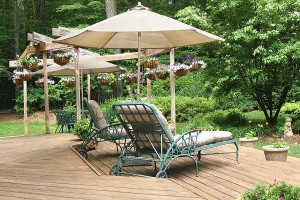 Having a new deck is probably the single most effective way to gain more enjoyment from your outdoor living space. You also face enough choices and decisions to make your head swim. We will do what we can to make that easier for you.
Having a new deck is probably the single most effective way to gain more enjoyment from your outdoor living space. You also face enough choices and decisions to make your head swim. We will do what we can to make that easier for you.
If you call us to discuss a new deck, we’ll ask a series of questions to help determine the best solution. We’ll also examine your structure to see how best to attach the deck. Most decks are not actually attached, they just look like they are. Physically attaching to your home could compromise the structure. Your decision to seek a professional deck builder is a good one because do-it-yourself decks are especially prone to unpleasant surprises.
Simply call or use the form on this page. We’ll provide the information you need to make a good decision. We hope you’ll decide to use our services, but at a minimum, you’ll be able to recognize the types of contractors you shouldn’t hire that prey on uninformed buyers.
Additional Deck Information
For your convenience if you would like more self help information about decks, we’re including that on the remainder of this page.
Most decks are built from one of the following materials:
- Pressure treated wood
- Cedar and redwood
- Ironwood (IPE)
- Composite
- Vinyl/PVC
Pressure treated wood decks
Pressure treated wood is the lowest cost option but also the highest maintenance and shortest life span. It’s also not a well kept secret that these decks are highly prone to warping, twisting, cracking, splitting, splintering, scratching, staining, and green, fuzzy beards. You can expect to be replacing boards during the life of the deck. Life expectancy is about 10-15 years when properly maintained.
Cedar and redwood decks
If you prefer a natural wood, cedar or redwood is a great option. The initial cost is higher than treated wood, but the life span is longer. It is still a high maintenance deck and requires initial and regular sealing. It does scratch and stain easily and is subject to some cracking and splintering. However, an important consideration here in the Seattle area is that it resists rotting. Life expectancy is about 15-20 years when properly maintained.
Ironwood (IPE) decks
Ironwood is your most durable choice with a reasonably low maintenance requirement, but it’s not without cons. It is the highest cost option and is very labor intensive, requiring pre-drilling of all fastener holes. The splintering is minimal, but it is highly resistant to deterioration and does not scratch or stain easily. Life expectancy is about 40+ years when properly maintained.
Composite and capped composite decks
Composite deck materials were developed to overcome the problems common to wood. They have a higher initial cost than wood, but reputable manufacturers warranty their products for 25+ years and they will last much longer than that when properly maintained. Maintenance requirements are low, but the idea of no maintenance is a myth. Every deck requires routine maintenance.
The problems associated with wood like rotting, splitting, splintering, cracking, and warping have been overcome. Composites also offer a good selection of color choices. However, they are soft and can scratch and stain, and are subject to slight fading over time. Capped composites were developed to overcome these drawbacks. Because of our Seattle climate, you should also be aware that composites can develop mold if not cleaned regularly.
Vinyl/PVC decks
Vinyl/PVC decks are the most resilient of your choices but are higher in initial cost. They will not scratch, stain, or fade, and have excellent warranties. The one downside is the color selection is more limited.
Deck Options
Above we mentioned that we will ask a series of questions to determine your best solution. This will include how you intend to use the deck so we can meet both your design preferences and the performance requirements. We help you account for those unexpected variables you wouldn’t otherwise think of such as a wild relative who convinces 30 adults to use your deck as a dance floor.
In addition to choices like a single level deck or multiple levels, you’ll also have other options to consider. These include:
- Low voltage LED lighting – This not only adds beauty but safety and security
- Baluster styles – Everything from standard round or square, to glass, aluminum with decorative accents, lighted, even custom and wrought iron
- Posts and post caps – Decorative post caps can embellish an otherwise standard post or add lighting, but you could also opt for brick or stone columns to match your home
- Railings – Although necessary for safety, you also have many options for making them more beautiful
We suggest you check out Trex, TimberTech, and Azek for some inspiring ideas on your new deck. These sites also showcase a lot of the lighting, baluster, post, and railing options mentioned above.
We would be honored to be interviewed to discuss your new deck. Call or use the form on this page to set up an interview.
